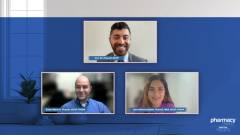
Patient Education and Monitoring in DLBCL Treatment
Health care experts provide insights into patient education, shared decision-making, and treatment monitoring in diffuse large B-cell lymphoma (DLBCL) therapies, reviewing education strategies and response monitoring.
Episodes in this series

This is a video synopsis/summary of a Practice Pearls involving Zahra Mahmoudjafari, PharmD, MBA, BCOP, FHOPA; Robert Mancini, PharmD; and Amir Ali, PharmD, BCOP, FHOPA.
In this segment, Mahmoudjafari interviews Mancini about the education and shared decision-making processes for patients receiving bispecific therapies in DLBCL. Mancini emphasizes the multidisciplinary approach involving pharmacists and nurses, highlighting the role of caregivers in patient education and decision-making. He stresses the importance of providing a comprehensive understanding of potential risks and manageable adverse effects.
Regarding patient monitoring and treatment plan adaptation, Mancini discusses the challenge of patients associating adverse effects with efficacy. He emphasizes the need to disassociate safety and efficacy in the patient's mind. Additionally, he addresses the importance of understanding the time to response, highlighting that tumor flares may occur, necessitating careful assessment to distinguish them from disease progression. Overall, the conversation underscores the significance of thorough patient education, involving caregivers, and monitoring responses to enhance treatment outcomes.
This summary was AI-generated and reviewed by Pharmacy Times® editorial staff.
Newsletter
Stay informed on drug updates, treatment guidelines, and pharmacy practice trends—subscribe to Pharmacy Times for weekly clinical insights.














































































































































































































